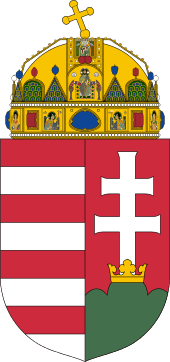Hungarian parliamentary election, 1949
 |
| This article is part of a series on the politics and government of Hungary |
| Foreign relations |
Parliamentary elections were held in Hungary on 15 May 1949.[1] The Hungarian Independent People's Front, an umbrella group created that February to replace the National Independence Front and led by the Hungarian Working People's Party (as the Hungarian Communist Party had been renamed following a merger with the Hungarian Social Democratic Party), but also including the remaining four non-communist parties, ran a single list of candidates espousing a common programme.[2] With all organised opposition having been destroyed,[3] and the Communists dropping all pretense of democracy,[4] the Front won 95.6% of the vote,[4] presaging the result of elections through 1990. 71 (17.7%) elected deputies were female, up from 22 (5.4%) elected in 1947.[5] Some 71% of those elected belonged to the Working People's Party, and a similar proportion were workers or peasants.[6]
The Communists had spent the last year and a half tying up loose ends in their bid for total power. They began the final push in October 1947, when they told their non-Communist counterparts to cooperate with a reconfigured, Communist-dominated coalition government or go into exile. By this time, Communist leader Mátyás Rákosi had become the most powerful man in the country.[7]
In June 1948, the Communists forced the Social Democrats to merge with them to form the Working People's Party. However, the few remaining independent-minded Social Democrats were quickly pushed out, leaving the party as essentially a renamed and enlarged Communist Party. Later in June, President Zoltán Tildy, a Smallholder, was replaced by Social Democrat-turned-Communist Árpád Szakasits. In December, Prime Minister Lajos Dinnyés was replaced by fellow Smallholder István Dobi, who made no secret of his sympathies with the Communists. On 1 January 1949, Hungary became a charter member of Comecon. On 6 February, Cardinal József Mindszenty, the spiritual leader of Hungary's Catholics and a prime opponent of Communism, was sentenced to life imprisonment. The Independent People's Front was formed in February. By the time of its first congress in March, it had become clear that it was to act as a vehicle for destroying rather than bringing together the main parties; many of the more courageous members of the non-Communist parties had already been forced to resign in the summer of 1948, and the four remaining parties had been turned into loyal partners of the Communists. Three months after the election, a new constitution proclaiming Hungary a People's Republic and enshrining the principle of one-party rule was adopted.[8] Schools were nationalised, collectivisation was launched, the bureaucracy was purged, the independent press was destroyed, and the last remnants of free enterprise were eliminated.[9] Also, László Rajk, General Secretary of the Independent People's Front and Foreign Minister, who the day after the election was the main speaker at a mass demonstration where he condemned Titoist "running dogs of imperialism", praised the "brilliant strategy" of the "great leader of the peace camp", Stalin, and the "wise leadership" of Rákosi--described as Stalin's best Hungarian pupil--was himself arrested two weeks later and executed in October following a show trial.[10]
This election marked the onset of 40 years of undisguised Communist rule in Hungary. Nonetheless, the government formed after the election was still nominally a coalition. The Smallholders received the Ministries of Trade and Religion and Education in addition to the premiership, and the National Peasants Party receiving Agriculture and Construction. After the election, the Front's local committees dissolved themselves, and with them the National Peasant and Independent Smallholder local organs, although no law or ordinance was ever passed abolishing them.[8] At this time, Dobi joined the Communists.
Results
| Party | Votes | % | Seats |
|---|---|---|---|
| Hungarian Working People's Party | 5,478,515 | 97.1 | 285 |
| Independent Smallholders Party | 62 | ||
| National Peasant Party | 39 | ||
| Independent Hungarian Democratic Party | 10 | ||
| Hungarian Radical Party | 4 | ||
| Independents | 2 | ||
| Against | 165,283 | 2.9 | – |
| Invalid/blank votes | 86,721 | – | – |
| Total | 5,730,519 | 100 | 402 |
| Registered voters/turnout | 6,053,972 | 94.7 | – |
| Source: Nohlen & Stöver | |||
References
- ↑ Nohlen, D & Stöver, P (2010) Elections in Europe: A data handbook, p899 ISBN 978-3-8329-5609-7
- ↑ Wittenberg, Jason. Crucibles of Political Loyalty, p.88. Cambridge University Press (2006), ISBN 0-521-84912-8
- ↑ Ekert, Grzegorz. The State Against Society, p.43. Princeton University Press (1996), ISBN 0-691-01113-3
- 1 2 Soberg Shugart, Matthew and Wattenberg, Martin P. Mixed-member Electoral Systems: The Best of Both Worlds? Oxford University Press (2001), ISBN 0-19-925768-X
- ↑ Tremblay, Manon and Galligan, Yvonne. Sharing Power: Women, Parliament, Democracy, p.26. Ashgate Publishing, Ltd. (2005), ISBN 0-7546-4089-2
- ↑ Kontler, László. A History of Hungary, p.409. Palgrave Macmillan (2002), ISBN 1-4039-0316-6
- ↑ Hungary: a country study. Library of Congress Federal Research Division, December 1989.
- 1 2 Swain, Nigel. Hungary: The Rise and Fall of Feasible Socialism, p.42. Verso (1992), ISBN 0-86091-569-7
- ↑ Rakowska-Harmstone, Teresa. Communism in Eastern Europe, p.90. Indiana University Press (1984), ISBN 0-253-31391-0
- ↑ Lendvai, Paul. Blacklisted: A Journalist's Life in Central Europe, p.68. I.B.Tauris (1998), ISBN 1-86064-268-3